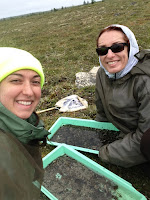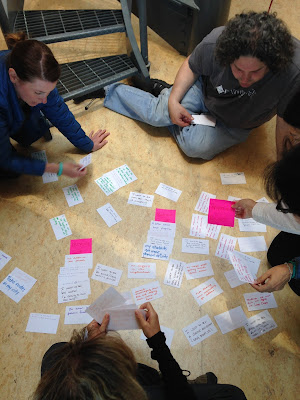Some highlights from yesterday
1. Breakfast: Bacon, Eggs, and Pancakes.
2.Team I was on for collecting data: Growth rate and stress-test team with Nancy in a most wooded environment than we've experienced yet.


3. What our team did: Collect tadpoles using aquarium nets if we could find them, had them swim in pre-measured water so they could release their stress hormones for 30 minutes, then put them in another container to be taken back to the lab and weighed.
4. Key Takeaway from doing this job: Some ponds have lots of tadpoles, some have none to be found. And it is not always the pond that you'd suspect that has a lot or a little bit of tadpoles. (For example, the huge pond had none, but the smaller pond with a lot of sedge had so many we couldn't count or catch them all.) And WEAR LAYERS! We sampled four ponds this morning and by the last one, I was sweating. The temperature went much higher than the forecast and I was glad I had a long sleeve layer I could remove.
5. In the afternoon: I didn't weigh tadpoles, (someone else did this) I instead worked on labeling tadpole pictures during mesocosm day with Carolyn. Sounds a lot easier and less complicated than it was.

6. Teacher workshop #3 of 5: Brainstorming solutions. The teams of teachers came up with some great solutions to their "How can we..." questions. Solutions involved, water conserving practices, science inquiry/literacy, recycling Tuesdays, and terra-cycling. Our next workshop is tomorrow evening and I'm really excited to see how the community action planning goes for these ideas!
7. Dinner: Don't remember but we had rice krispies for dessert. I had two.
8. Evening Activity: Beluga Whale talk by Pierre Richard, retired researcher of Beluga Whales. He told us lots of basics about Beluga whales but one of the main questions he posed was, "Why do the Beluga Whales choose to gather in the thousands in the Churchill river estuary (the place where I did my kayaking two days ago.) Is it for feeding? No, there isn't an over abundance of their food source there. Is it for birthing and raising their calves? No, they do that in other places too. Is it for socializing? No, they socialize wherever they are. Is it to conserve energy because the temperatures are warmer in the river? No, there blubber doesn't change in thickness due to a season in the estuary. Is it to avoid predators? YES! (or at least Pierre Richard thinks so.)

Apparently, Orca's hunt belugas and you might think that a same entry/exit estuary seems like a terrible place to hide because if an Orca comes in it would be like a smorgasbord, but that rarely happens because the river is shallow (only 40 feet at the deepest channel in the middle) and Orcas like much more than that. They fear getting beached because if they do they die (apparently the weight of their body crushes their internal organs until they bleed to death internally...ugh, what a terrible way to go.) Belugas on the other hand often allow themselves to get beached and as long as man or a polar bear don't find a beached Beluga then it just goes back out to see when the tide comes back in. Fascinating, huh!?!
9. Before bed activity: I spent 1.5 hours putting a puzzle together with some other teachers. It is a frog puzzle (fitting, eh). We finished 3 of the frogs in that sitting.
Today, we had french toast for breakfast, Tacos for lunch, and barbecued chicken for dinner. Today was also my day to volunteer in the kitchen. That means that during the last 20 minutes of meal time, I help the on-staff-volunteers with whatever tasks they need done. Sometimes it's washing dishes, today it was wiping down tables ans sweeping.
We got out in the field around 9am and today it was cold (47 degrees) and raining. I was on the "physical team today." That meant that I had to collect visuals of the pond via panoramic shots. Use a GPS to walk the perimeter of the pond to find the surface area, measure the depth at 15 locations, estimate the amount of surrounding sedge and shrub, and draw a diagram of an aerial view of the pond. As difficult as that all sounds, it was actually one of the easiest and fastest jobs I've done which means when I finished it, I'd go help the dip-net team identify organisms in their trays or help the growth rate team collect more tadpoles. I wasn't cold or wet from the weather, but my fingers were freezing, my only complaint.
Because there is no data to process in the lab when on the "physical team," I got to go out again in the afternoon and help Steph, one of the masters students with her frog tracking data. She tracks frogs using a little transmitter which they wear, and she uses a telemeter device to find the frogs and compare their location to where they were the last time she found them to see what habitats they like and how far they will move in a habitat. Using the telemeter was hard but kind of felt like a treasure hunt. It was like a mini-celebration when you got a visual confirmation of the frog wearing the transmitter you're tracking.
Post dinner I played Euchre for the first time with Canadians. Sure enough, me and my teammate Steph (also from the U.S.) won. I think it was the fact that we milked the cow when we were in the barn. All you Euchre players from Ohio know what I mean.
The evening activity was picking wildflowers that will later be made into a jam. I guess that is something we are going to do on another evening. Stay tuned for jam-making! We decided to put the flowers to another use in the meantime by making sculptures.





















































